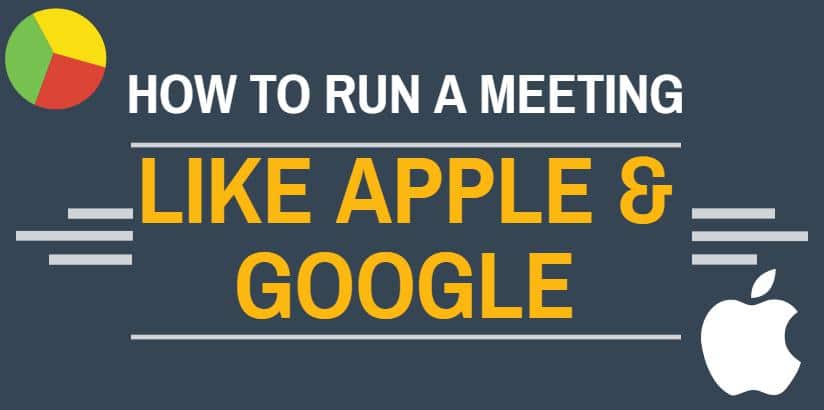
How to Run Your Meetings like Apple and Google
Let us all share in a moment of silence for the precious time, productivity, and attention spans we have lost to a bad meeting – they will be dearly missed. Bad meetings: time-wasting, draining, staring-into-space groups of people who talk a lot and don’t listen much. In fact, the only thing worse than not having a meeting, is having a bad meeting.
But a good meeting is something different. “It’s the most efficient way to present data and opinions, to debate issues, and yes, to actually make decisions,” says Google’s former CEO Eric Schmidt. Innovative new companies are re-writing the rules of the meeting game, and we’ve sifted through their best tricks so you don’t have to!
So many great companies are stuck in a traditional, predictable meeting structure. But top companies like Apple and Google believe we can always reinvent the wheel. Given that they’re two of the most innovate and powerful companies of all time, I’m going to stick with them.
Here’s how to steal a little bit of their genius for your own meetings:
-
Have a stated agenda or purpose.
At no point should an attendee be staring off into space contemplating, “Why am I here?” Set an agenda, clearly designate the sequence of events, and stick to it. This will ensure no one’s time gets wasted.
-
End with clear, actionable steps.
Successful organisations demand that attendees walk away with concrete tasks. This tactic ensures that the motivation and momentum of the meeting continues afterwards.
-
Stick to the clock.
There’s an old adage that goes “work expands to the time you schedule for it”. Set a clear end time, and the constraint will breed creativity and prevent tangents and rambling. If you have to set an alarm, do it. Google pressures employees to remain focused during meetings by projecting a massive clock or countdown on the wall. Nothing like an ominous “tick tock” to keep your head in the game.
-
Get a DRI
This is one of the keys to Apple’s incredible productivity. Have a Directly Responsible Individual listed next to every agenda item they are responsible for. When there’s someone appointed to every task, there’s no time to be waste being confused over who’s doing what. The shame of public accountability has an incredible power to put people to work.
-
Challenge and be challenged.
While you don’t have to go all Steve Jobs and bring your employees to tears, it’s important that employees at meetings are ready to defend their work and ideas against honest criticism. If a team member doesn’t have an idea to defend, why are they at the meeting?
-
Appoint a clear decision maker.
Notice that there’s no “s” on the end of that last word. Google owes a lot of its success to acting “like a hungry start up” according to CEO Larry Page. When companies grow, increases in bureaucracy, departments, and all that red tape, can drag meeting and decision-making efficiency. Each meeting needs a singular decision maker to end wasteful deliberating.
-
It’s not a party.
More is not merrier, and no, you cannot bring a plus one. For Steve Jobs, meetings are for small groups of smart people; everyone attending should be essential. Top experts suggest capping attendance at 10 people and every one of them should have something to contribute.
-
Switch off.
Incase you misread: meetings are for smart people, not smartphones. Unless they’re essential to your work, make like Obama and ask your attendees to ditch their phones at the door. Employee engagement and creativity will flourish in a phone-free zone. If you need something to fiddle with instead of your phone, you can always backtrack to pen and paper (remember that?). Old-school note taking will also make for much better conceptual recall than digital notes. You can even try your hand at doodling! It may appear absent-minded, but a 2009 study at the University of Plymouth found that doodlers retain 29% more information from meetings than their non-doodling counterparts. Try telling that to your old schoolteacher.
-
Kill meetings, kill ideas.
Not altogether, but get rid of the excess. Your meetings should be a reflection of your company, and you want to see streamlined focus at every turn. So, stop slowing your own progress and kill the non-essentials.
-
Decisions should never wait for a meeting.
Waiting for a meeting to make a decision ties the velocity of the company to its meeting schedule. If a meeting is necessary, make it happen as soon as possible.
-
Schedule free time for employees afterwards.
Meetings can be taxing and stressful, and employees can benefit from some time to relax and get fresh ideas flowing. Top companies allow their employees paid free time after meetings to improve their overall performance. If you’re worried about slowing productivity, the 20% free time given to Google employees resulted in the creation of the incredibly successful Google Earth and Gmail.
-
Location, location, location!
Finally, if it’s not necessary to hold a meeting in the boardroom, holding meetings in a park or local café is a great way to increase attentiveness and innovation. A more relaxed environment allows ideas to flow freely, and will encourage more employees to engage. You may even start to find meetings *gasp* enjoyable?
So, there you have it. Now you’ve got all the expert secrets to running meetings that energize and don’t demoralize. Congratulations! You’re now running the motivating, productive meetings of your dreams. If you’re still unsure about any of these ideas, think about the last time you Googled something or saw an iPhone… I think you’re in pretty safe hands.